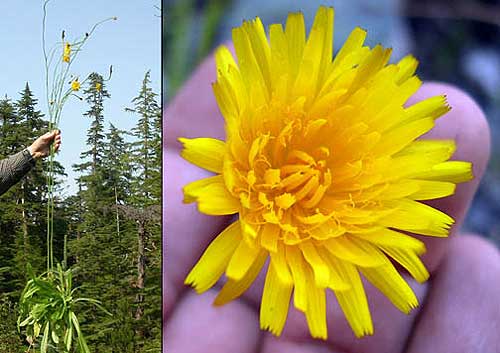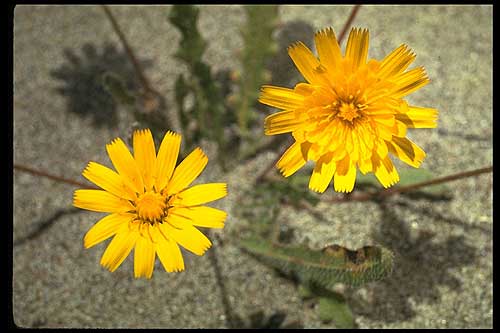 Green, leafy invaders finding
a home in Alaska
Green, leafy invaders finding
a home in Alaska
March 15, 2008
Saturday
With only five roads connecting it to the outside world, and
a small number of airports and seaports, Alaska is more like
an island than the peninsula it is. That isolation has helped
save Alaska from the widespread invasion of non-native plants,
but exotics are finding their way in.
In 1968, Eric Hulten documented about 175 exotic plant species
in Alaska. During a 2006 count of Alaska plants, researchers
came up with about 275 plants new to the state. Those plants
have made it into the state as their seeds have hitchhiked in
on vehicles and by other means. Alaskans have also imported non-native
seeds in bales of hay and potted soil.
Jeff Conn has studied the latter two pathways for weeds to gain
access into Alaska. He is a weed specialist with the USDA Agricultural
Research Service who also is an affiliate faculty member at the
University of Alaska Fairbanks. Conn, Casie Stockdale, and Jennifer
Morgan purchased bales of hay and straw from Alaska feed stores
and then shook out the bales over screens. After seeds fell onto
the screens, they planted them, and up popped 15 weed species
not known to grow in Alaska, along with 17 types that already
grow here. Because people spread hay and straw in horse corrals
and dog yards-both places with disturbed soil and plenty of fertilizer
- imported hay and straw bales could be significant vectors of
alien plants in the Alaska countryside.
 The Hairy catsear grows
in meadows, gardens, roadsides, and waste
The Hairy catsear grows
in meadows, gardens, roadsides, and waste
areas. This perennial herb is especially common in Southeast
Alaska.
Robert Potts, California Academy of Sciences photo.
Why should anyone care about Alaska having more plants, especially
some that result in pretty colors along our roadside from varieties
such as the blue-flowered bird vetch or the purple loosestrife?
"You want to preserve an ecosystem the way it is,"
Conn said. "(Invasive species) can change the speed or direction
of plant succession, they can compete with and eliminate other
plants, and they can change fire frequencies (cheatgrass, a common
invader in the west, flourishes and then dies in the same season,
leaving behind a flammable understory).
Along with testing for weeds in hay and straw bales, Conn and
his coworkers also sieved the soil that comes with plants people
buy at box stores and nurseries. Some were clean, but most soil
had weed seeds. From the potted soil, the researchers germinated
54 plants different than those people thought they were buying
from stores in Anchorage, Juneau and Fairbanks.
Alaska's problem is small compared to other states. California,
for example, had about 100 exotic plants in 1860, and 10 times
that a century later.
 Hairy catsear is an
invasive plant that is spreading into Alaska.
Hairy catsear is an
invasive plant that is spreading into Alaska.
Photo courtesy U.S. Forest Service.
"Alaska still doesn't have serious problems with invasive
plants," said Trish Wurtz, an ecologist with the U.S. Forest
Service in Fairbanks. "We're still in the prevention mode,
so there's still a chance to do some good. We're the only state
in this situation."
How do you beat back the invaders, especially in these times
of hyper commerce? Conn said awareness of the problem is important,
and that Alaska's isolation could work in its favor; inspectors
could stop invasive weeds before they head into Alaska.
"We only have about 13 points of entry into the state,"
Conn said. "It should be feasible to prevent (exotic plants
from coming through them.)"
Conn said once an exotic plant has spread to more than one acre,
there's no chance of eliminating the plant.
"I think of them as being like an oil spill," Conn
said. "If you can prevent it from happening, it's so much
more cost-effective."
This column is provided
as a public service by the Geophysical Institute,
University of Alaska Fairbanks, in cooperation with the UAF research
community. Ned Rozell is a science writer at the institute.
E-mail your news &
photos to editor@sitnews.us
Publish A Letter in SitNews Read Letters/Opinions
Contact the Editor
SitNews
©2008
Stories In The News
Ketchikan, Alaska
|


